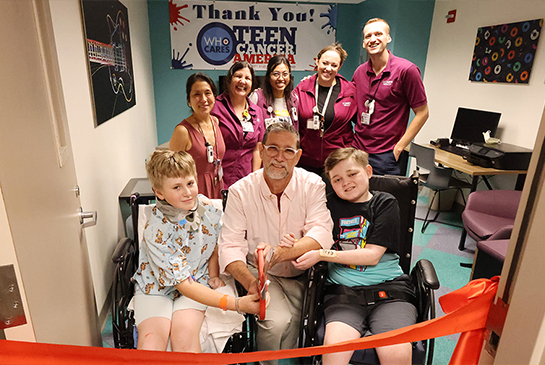Pediatric Cancer Care
Pediatric Cancer Types We Treat
At UC Davis Comprehensive Cancer Center, we provide cancer care for children, adolescents, and young adults with all types of cancers. Explore our cancer types to find detailed information about treatment options, our collaborative team approach and the support services that are available to our cancer patients.
Leukemia is a cancer of the white blood cells and is generally regarded as the most common form of pediatric cancer. Leukemia occurs when the bone marrow produces a large number of abnormal white blood cells. Symptoms may include fever, decreased energy and appetite, weight loss, swollen lymph nodes, bone pain or easy bleeding/bruising. The diagnosis is usually suggested by abnormalities on laboratory measurement of the complete blood count (known as a CBC) and confirmed by performance of a bone marrow aspirate and biopsy.
In children, the major forms of leukemia are acute lymphoblastic leukemia (ALL) and acute myelogenous leukemia (AML). Both ALL and AML are treated with intensive chemotherapy, with the potential for radiation therapy or stem cell transplantation. The overall prognosis for childhood leukemia has improved in recent years, though certain subtypes require more intensive therapy.
Lymphoma is a cancer that begins in the cells of the immune system. Symptoms may include fever, drenching night sweats, decreased energy and appetite, weight loss, painless swelling of the lymph nodes (in the neck, underarm or groin), bone pain or unexplained itchy skin. Since laboratory testing of the blood may be normal, lymphoma is typically confirmed by a biopsy of an enlarged lymph node.
In both children and adults, there are two basic categories of lymphoma: Hodgkin lymphoma and non-Hodgkin lymphomas. Both types are treated with intensive chemotherapy, radiation therapy and/or surgery. Stem cell transplantation may also be considered in those patients with resistant or relapsed lymphomas.
Brain tumors are the most common solid tumors found in children. There are many different subtypes, with the most common malignant subtype being medulloblastoma (which is discussed separately below). Brain tumors are formed by abnormal growths and can appear in different areas of the brain. Benign (not cancerous) tumors may grow and press on nearby areas of the brain, but they rarely spread into other tissues. Malignant (cancerous) tumors are more likely to grow quickly and spread into other brain tissue.
Whether a tumor is malignant or not, any mass that grows into or presses on an area of the brain may stop that part of the brain from working the way it should. Symptoms can vary greatly, but may include headache, visual changes, vomiting, difficulty walking, etc. Therapy for brain tumors varies depending on the subtype, but will generally include a combination of chemotherapy, radiation therapy and/or surgical resection.
Medulloblastoma is a malignant (cancerous) brain tumor that usually afflicts only children and young adults. Medulloblastomas most often form in the cerebellum, which controls movement, balance and posture. Symptoms may include headache, visual changes, vomiting, difficulty walking or clumsiness.
Diagnosis of medulloblastoma is typically confirmed by a computed tomographic (CT) scan, or a magnetic resonance imaging (MRI) scan of the brain. Since medulloblastoma can spread to the bone, bone marrow, lymph nodes, liver, or lung, other imaging tests are also required to determine the full extent of the disease. Treatment will generally involve a combination of chemotherapy with surgical resection, as well as potentially radiation therapy.
Neuroblastoma is a malignant tumor composed of immature neurons (nerve cells). Because it attacks the nervous systems of infants and children, it can trigger movements of the eyes, erratic muscular jerks or even chronic diarrhea. Most frequently, neuroblastoma occurs in the nerve tissue of the adrenal glands, which sit atop the kidneys and produce hormones that control blood pressure and blood sugar, among other functions. Less commonly it may also begin in the neck, chest, abdomen, pelvis or spinal cord.
Neuroblastoma is most commonly diagnosed in children younger than age 5. In rare cases, the tumor may form and be diagnosed before birth. There is both a genetic and non-inherited form. In those patients with a genetic-based form (in which a genetic mutation is passed from the parent to the child) the tumors often occur earlier than in cases with no genetic basis. Neuroblastoma may disappear completely in infants without any therapy or mature into non-malignant neurons.
A diagnosis of neuroblastoma may be made through urine testing, bone marrow aspirate/biopsy and imaging by CT or MRI. Since neuroblastoma can spread to the bone, bone marrow, liver and skin, nuclear medicine studies such as MIBG scan are used to determine the extent of disease spread. Treatment of neuroblastoma is highly variable and ranges from surgical resection only to the inclusion of intensive chemotherapy, radiation therapy and stem cell transplantation.
Retinoblastoma is the most common eye tumor found in children and is usually diagnosed in children less then 3 years of age. About one-third of patients are born with a genetic mutation that leads to very early formation of the tumor in one or both eyes. Most children have no symptoms, but the diagnosis is usually suspected when a “white reflex” in the eye is noticed in a photograph (versus the well-known "red eye" photographic effect) or by a pediatrician.
Confirmation of the diagnosis requires a thorough examination of the eye by a qualified ophthalmologist, in conjunction with an MRI. Since retinoblastoma can spread to the bone, bone marrow and cerebrospinal fluid, a bone scan, bone marrow aspirate/biopsy and lumbar puncture are also routinely performed. Chemotherapy is administered with the goal of saving the eye and as much workable vision as possible.
A sarcoma is a cancer of the bone, fat, muscle, cartilage, or other connective or supportive tissues such as tendons, blood and lymph vessels, and nerves. There are numerous types of childhood sarcomas, some of which are outlined below.
Osteosarcoma
Osteosarcoma is the most common type of bone cancer seen in children and generally occurs in patients between 10-20 years of age. It occurs most often in the bones around the knee and in the upper arm, though it can happen in any bone of the body. Typical symptoms include pain, swelling or a fracture in the bone.
The diagnosis of osteosarcoma is usually made with x-rays, MRI and biopsy of the involved bone. Since osteosarcoma can spread to the lungs and other bones, CT of the chest and bone scans are regularly performed to look for evidence of disease spread. Treatment is intensive, and includes chemotherapy, surgical resection, and radiation therapy.
Ewing’s sarcoma
Ewing’s sarcoma is the second most common type of bone cancer seen in children and, like osteosarcoma, generally occurs in patients between 10-20 years of age. Unlike osteosarcoma, however, Ewing’s sarcoma can also manifest itself as a soft tissue mass anywhere in the body. Typical symptoms include pain and swelling at the site of disease.
The diagnosis of Ewing’s sarcoma is usually made with x-rays, MRI and biopsy of the involved bone or soft tissue mass. Since Ewing’s sarcoma can spread to the lungs, bone and bone marrow, CT of the chest, bone scan and bone marrow aspirate/biopsy are performed to determine the extent of disease spread. Treatment is intensive and includes chemotherapy, surgical resection, and radiation therapy.
Rhabdomyosarcoma
Rhabdomyosarcoma is the most common type of soft tissue sarcoma in children, with the cancerous cells forming in muscle tissue. The cause is unknown, although certain genetic conditions may increase the risk of disease. There are two types of rhabdomyosarcoma that primarily occur in children: embryonal, the more common type, occurring most often in the head, neck, genital or urinary organs; and alveolar, which tends to occur in later (teen) years, most often in the limbs, torso, or genital/anal area.
Since rhabdomyosarcoma may arise anywhere in the body, symptoms tend to be variable, but typically include pain and swelling at the site of the disease. Diagnosis is made by x-ray, MRI and biopsy of the soft tissue mass. Since rhabdomyosarcoma can spread to the lungs, bone and bone marrow, CT of the chest, bone scan and bone marrow aspirate/biopsy are also performed to determine the extent of disease spread. Treatment is intensive and includes chemotherapy, surgical resection, and radiation therapy.
Wilms’ tumor is the most common kidney tumor found in children and generally occurs in children younger then age 5. Children may present with an enlarging abdomen, abdominal pain, fever, vomiting or blood in the urine, although some children may have no symptoms at all. Diagnosis is generally accomplished through abdominal ultrasound or CT scan.
Treatment of Wilms’ tumor almost always involves surgical resection. However, since Wilms’ tumor can spread to the lungs, lymph nodes, liver, bone or brain, treatment may also include radiation or chemotherapy. With proper treatment, Wilms’ tumor is considered to be a highly curable cancer.



